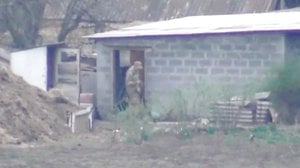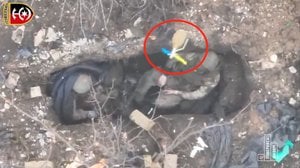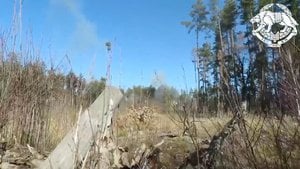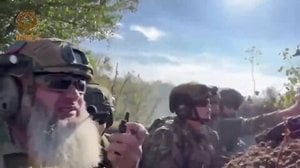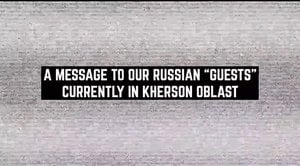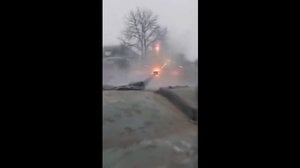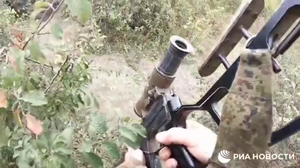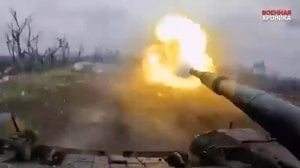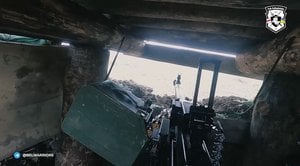
(NSFW) 47th Brigade Infantry Assault
Published 1 years ago
Note: We attempted to embed Markus' version of this video, which featured English subtitles, directly from YouTube, but could not for technical reasons. We have provided links to his YouTube and Instagram accounts at the end of this analysis and recommend that you view the video with the translation.
This is a long form edited video of an assault conducted by the Ukrainian 47th Mechanized Brigade of a Russian defensive network. This western-equipped unit has been engaged on the southern front of the Ukrainian counter-offensive, and has experienced some significant vehicle losses, including Bradley Infantry Fighting Vehicles (IFVs) and Leopard 2A6 main battle tanks (MBTs). As of late June, the 47th Brigade June 28 is operating near Robotyne, Zaporizhia, after successfully gaining ground. The video is forty-five minutes in duration and is mostly shot with helmet mounted camera and what appears to be a phone camera. The operator is Valerii Markus, 47th Brigade sergeant major. Mid-way through the video he turns the camera on himself to offer some candid assessments of their progress. The video is translated with subtitles, and some of the translation is not entirely accurate, but close enough to gain an understanding of events. This video is longer than many posted by our site and offers insight into the conditions encountered by Ukrainians and the tactics they employ as they attempt to recover territory from the Russians, as well as an outstanding study in small-unit leadership.
The video begins, as it should, with prep for combat as Sergeant Major Markus lubes and conducts a function check of his rifle. He carries an AR variant, and all of the rifles seen in use by soldiers of the 47th Brigade appear to be AR or M16 variants, some with M203 grenade launchers. The initial assault is of a trench system in a copse of trees, and after evading a drone the soldiers take cover from enemy indirect fire (IDF). As they move into the tree line, Sergeant Major Markus identifies an enemy machine gun and directs fire, instructing his troops to engage with precision fire and to not reveal their locations. Artillery and small arms fire suppressed the machine gunner.
The video cuts to the consolidation phase of the assault and the interrogation of a Russian prisoner. He reveals that he is a prisoner, released from captivity to “dig trenches,” has been in his position for only a few days, and knows little of his unit’s equipment, tactical situation, or even the name of his commanding officer. The interrogation is thorough and intense, and though Sergeant Major Markus is not necessarily cruel, he has no sympathy for his captive. The video skips forward again to the unit in a recently captured trench, engaged by enemy small arms fire, and treating wounded in a captured Russian dugout. The wounded are evacuated, and the unit develops its plan for seizing the next objective, a trench system in a copse of trees that is not connected to the other Russian positions by trenches or foliage, meaning that their approach will be in the open and exposed to observation and fire.
As night falls, Sergeant Major Markus and a few other soldiers remain in a forward position while the remainder of the unit falls back to the previously captured trench. He consolidates the defense under brisk gunfire and settles in for the night. The sergeant major gauges the mood of the men, asking who is afraid and not ready to fight, and insisting that he will not force them to do anything they do not wish to. They reply that they are afraid but are ready. Sergeant Major Markus develops for the next day, maximizing the assets that they have, and reminding his men that either they advance, or they leave, because the artillery will destroy them.
After a night spent sleeping on the corpses of Russians killed the previous day, the unit is reorganized to continue the assault. After communicating the plan, Sergeant Major Markus takes time to encourage Sapper and to wish him luck. Taking pains to remain unseen, the unit crosses open ground and gains a foothold in the final copse of trees. The video cuts to the team moving through Russian trenches littered with corpses, equipment, and rubbish, and they exercise caution, looking for boobytraps and mines. The video ends with the unit taking stock of the captured equipment, food, and even a hookah, and stopping for a well-earned rest. Sergeant Major Markus points out the knocked out Russian tank adjacent the trench and discusses the merits of some of the captured equipment. The Russian trench is filthy, filled with scattered ammunition, clothes, equipment, and trash. A note at the end of the video observes that no Ukrainian soldiers were killed taking the position.
This video provides outstanding examples of solid infantry tactics, techniques, and procedures, and progress through the Russian trench system was deliberate, methodical, and yet maintained momentum. The reaction to the drone appeared well-rehearsed and reminds me of the days when units assigned air-sentries, a practice that fell out of favor in American units during the global war on terror (GWOT). Command and control was outstanding, and the plans developed were simple and clearly communicated. The 47th Brigade supported movement with accurate artillery fire, and machine guns were coordinated with artillery to support the attack. Though the only Ukrainian machine gun seen in the video was a PKM, I had the impression that they employed their machine guns as support by fire assets in the U.S./NATO fashion.
Throughout the video Sergeant Major Markus assigned sectors of fire, methods of fire control, and rates of fire. These soldiers have clearly been training in shooting techniques that would be familiar to U.S. or NATO troops, and just prior to an assault on a tree line, he takes the time to remind a young solder to engage using controlled pairs. They maintained a deliberate rate of advance that was far from reckless, moving from cover to cover with good awareness of conditions on the flanks. The movement to the final trench system emphasized stealth, moving silently, and using stealth to ensure surprise, and at one point Sergeant Major Markus advised his soldiers to crawl over green grass, and not dead grass or branches that might create excessive noise. They displayed caution moving through trenches and employed sappers to clear routes to the objective. Combat medics also seemed well-equipped and competent, and casualty evacuation was clearly well practiced and deftly executed.
The most outstanding aspect of this video was its demonstration of excellent and inspiring small unit leadership. Throughout the video, Sergeant Major Markus was attentive to his soldiers and their needs. In addition to offering clear direction, he set an example, and insured that the unit remained focused on its objective and that it maintained momentum. It is not just a leader’s actions and decisions that matter – words can shape a unit’s morale and affect performance, and small words and gestures can matter. Throughout the video Sergeant Major Markus addressed his soldiers as “friend” or “my friend,” and he took the time to give a soldier a unit patch, address a young soldier by his first name, encourage a sapper before a breach, or banter with a junior officer. He took the time to acknowledge fear and to ask rather than demand, and his style of leadership yielded results. The decisions made and the manner in which they were taken were indicative of a cohesive unit with a strong esprit de corps.
An interesting moment, which is easy to overlook, was when Sergeant Major Markus referred to his men as “Warriors of Rohan,” a reference to J.R.R. Tolkien’s Lord of the Rings. Tolkien was a professor of Anglo-Saxon literature and a linguist, and he served on the Western Front in World War I. The Lord of the Rings was written by Tolkien after the war, and edited by his son, Christopher, who served in World War II, and though Tolkien denied that his work was an allegory for World War I, he eventually admitted that it was an allegory for the experience of war. The epic depicts an existential struggle between the free peoples of the world and an evil foe in the east, and the Riders of Rohan, essentially Saxon warriors on horseback, emerge in the second book of the trilogy and arrive at a critical battle in the third book. It is easy to see why the story would resonate with the Ukrainian people and their armed forces, and since the invasion of Ukraine by Russia last February, Ukrainians have referred to Russian soldiers as orcs, the primary soldiers of the Dark Lord, Sauron. That a Ukrainian unit would style itself after the heroes in an epic tale of a struggle between good and evil does not seem surprising or silly. Referencing history or myth to imbue a unit with a warrior spirit, and to inspire honor, dedication and a sense of purpose is an important aspect of leadership, and I thought the comment well-timed and appropriate.
This video is an in-depth glimpse into a unit that is motivated, well-trained, and ably led. Western influence is obvious in equipment, tactics, and command style, and the benefits are clear. More significantly, this footage is a demonstration of the role of and necessity for light infantry on the modern battlefield. I have long felt that the Russian dependence on mechanized forces and its dearth of dismounted infantry has not served it well, and that light infantry brigades and divisions add balance to the force. While IFVs and APCs can offer some protection from small arms and shrapnel, the proliferation of anti-armor systems mitigates their value. Light infantry, however, is well suited to negotiating mine fields and assaulting trench systems concealed in wooded areas, as demonstrated in this video.
Ultimately, I was impressed by the tactical ability of the 47th Brigade and by the individual small unit leadership displayed by Sergeant Major Markus. He is a reminder that true leaders can inspire through encouragement and a positive example, and that a leader is not measured by the volume of his voice, or by the number of expletives delivered in a sentence. I anticipate that some viewers might be critical of a non-commissioned officer of his rank engaging in small unit action, but for this unit and in this conflict, it seemed appropriate to me. The 47th was formed last year after the Russian invasion, and quickly expanded from a battalion to a brigade. Its ranks include conscripts, volunteers, and professional soldiers, and like the citizen soldiers that fought in the United States military in World War II, they are representative of their nation. Sergeant Major Markus reminds me of a World War II-era NCO, men who were often promoted quickly, like Audie Murphy, and who would exert individual leadership at the tactical level to maintain momentum and to keep a unit moving forward.
Markus is an original creator on YouTube and Instagram. You can find his content on YouTube @MarkusUA or on Instagram valerii_markus
About the Author
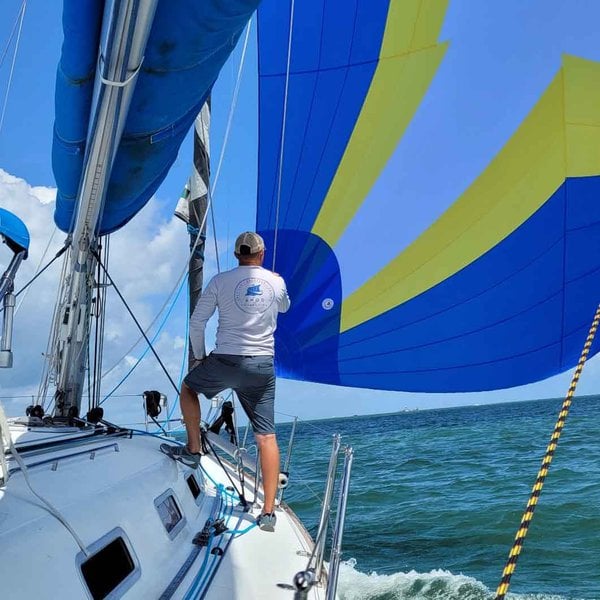
Cam
Cam served as an infantry officer in the Marine Corps, deploying to the Horn of Africa and participating in combat operations in Iraq. He currently works in the maritime industry and in the defense sector as an instructor of combined arms planning and operations. An avid sailor, Cam founded and directs a nonprofit that supports veterans and first responders through sailing.



